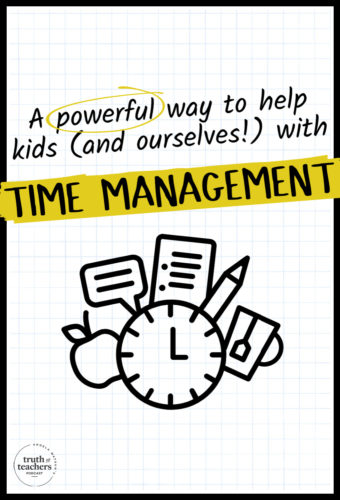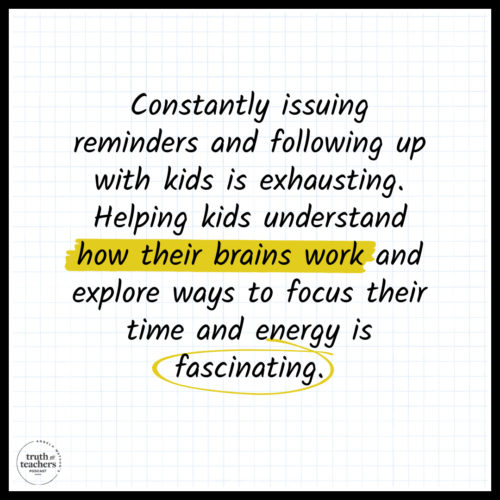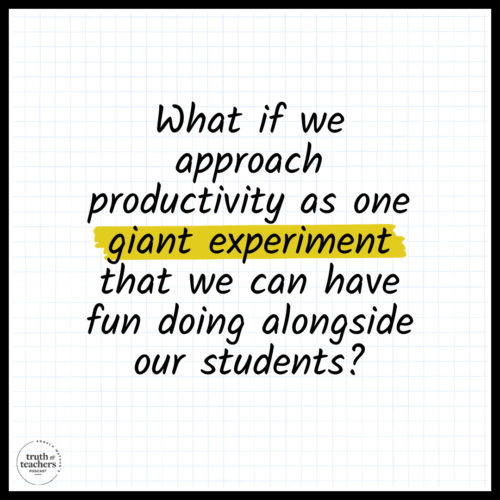Time management skills are needed by kids now more than ever.
While students have always been late to class, lost assignments, and forgotten to turn things in, the battle for focused attention seems magnified these days for sure! Constantly issuing reminders and following up with kids is exhausting. But helping kids understand how their brains work and explore ways to funnel their focus, time, and energy is fascinating.
So, what if we approach productivity as one giant experiment that we can have fun with doing alongside our students? Learning to manage your time is a highly personalized lifelong process, and it can actually be a fun adventure if you approach it through a self-development lens.
Read (or listen) to learn more about how there’s no “right” or “wrong” approach to managing your time, and how to teach kids that it’s normal and okay for productivity levels to be inconsistent.

Listen to episode 223 below,
or subscribe in your podcast app
Sponsored by Advancement Courses and 40 Hour Teacher Workweek
Approach productivity as a (fun!) life-long experiment
There’s something a bit bigger than the practical strategies that I think is too important to miss. You know I’ve been supporting teachers with time management through the 40 Hour Teacher Workweek program since 2015, and I’ve paid careful attention to what techniques work and which ones don’t. There’s a mindset, a perspective, or perhaps a lens that many of the most productive people have which makes it possible for them to manage their time well.
The overarching belief that ties all the other mindset and time management strategies together seems to be this:
Productivity is one giant experiment. Learning to manage your time is a highly personalized lifelong process, and it can actually be a fun adventure if you approach it through a self-development lens.
The teachers who are most successful at managing their time don’t see it as a burden.
They don’t see mismanaging their time as a failure: it’s part of the experiment of learning what works for them and what doesn’t. They’re constantly trying out different approaches according to their moods and the changes in their workload, and adapting for new changes and preferences. It’s not something they try to figure out once and for all.
Having this perspective on your own time management naturally flows over into the way you treat students.
You no longer expect them to just “buckle down and get it done” since you’re aware of all the mental tricks and productivity hacks you yourself use to follow through on tasks. You no longer get as frustrated with kids who waste time because you understand some of the root causes, and you have tools to help.
Constantly issuing reminders and following up with kids is exhausting. Helping kids understand how their brains work and explore ways to funnel their focus, time, and energy is fascinating.
So, how do you approach time management through this lens?
First, it’s important to know and communicate to kids that time management is a learned skill. If you’re a person who is constantly late or behind, you’re not doomed to be that way forever. Certainly, time management is easier for some folks than others, but anyone struggling needs to know explicitly that there is nothing wrong with them; they just haven’t yet found systems that work for their personality and needs.
The other important piece here is that it’s a lifelong process. My approach to my workflow changes all the time. A routine or habit will work well for a couple of days or weeks or even a few months, then just stop working. Again, this does not mean something is wrong with me or my approach. I just need to be flexible and experiment with a different approach.
That word experiment is key. It means we’re tinkering with things, playing around, trying stuff out.
And when it doesn’t work, that’s important information to know. It’s not a fail: it’s feedback.
I think this is a message most of us did not learn growing up. We were given tasks and expected to manage our time and get them done. Kids today have a lot more information coming at them, it’s a much noisier and crowded space. And yet they’re often expected to have skills adults don’t have.
I struggle to get out of bed and get to work, and I work for myself and get paid for it! Imagine having to work 6 hours a day and not get paid, and not get to choose what work you’re doing. It’s no shocker that kids aren’t inherently motivated to be on time and put forth 100% effort. This is natural and normal for them to struggle to get their school work done.
So we can’t just expect kids to juggle everything and understand how to best use their time, particularly when we know as adults how hard it is even with our maturity levels and fully developed brains. Many of us are not great role models for children in this area, either, because time management IS so difficult, so they really don’t have anyone to emulate. They often emulate our bad habits.
And, we can’t just TEACH kids how to manage their time. That’s the other thing about productivity that is often misunderstood. There’s an endless amount of ways to get things done, and none of them are really right or wrong. And none of them always work in every situation for every person.
So what if we approach this as The Great Productivity Experiment?
What if we no longer expected ourselves, our partners, our colleagues, our families, or our students to know how to use their time well intuitively, but to expect that we’re all experimenting?
What if we created space for low moods and high moods, low energy days and high energy days, active mornings and active nights, all different kinds of routines and approaches ?
What if we focused on building a toolbox of options to choose from?

That’s what I’m suggesting here: that you approach time management as a fellow learner alongside your students.
You’ve found through trial and error things that work for you and learned what doesn’t. You know if getting up earlier helps, or makes things worse, for example. And you know this because you’ve done it both ways over and over again.
Children are still learning about themselves, even more than we are. Most of them don’t know yet if getting up 15 minutes earlier is going to be worth it. And they don’t know that some days, it might feel worth it and sometimes it might not, and that they need to be in tune with their own bodies and own needs. We can validate for them, and show them that the way we manage time is impacted by our moods, physical/mental/emotional health, the weather, seasons, circumstances, and more.
So some of the key ideas you want to internalize and then teach to students are:
- Productivity is a great lifelong experiment in self-development.
- The experiment involves observing what you need to best function.
- Time management involves managing much more than time: it’s managing energy and focused attention, as well.
- There’s no “right” or “wrong” approach.
- It is normal and okay for productivity levels to be inconsistent.
I’m working on a brand new resource that I hope will be done for back-to-school to help you conduct the great productivity experiment with your students. It’s a combination of personal development and professional development for teachers plus curriculum for students. So, sort of like this episode, it’s teaching you the principles and how to experiment with them, and giving you the lesson plans and teaching materials to share those experiments with your students and work through the process together.
I’ll let you know here on my podcast and via email — if you’re on my email list — when that resource is ready in late July. And if you’re part of the 40 Hour Teacher Workweek — either joining this summer or in the graduate program — this new resource will be included with the back-to-school resources so you’ll get it at no additional cost.
Teach kids multiple options for managing their time
In the meantime, I want to share some ways members of 40 Hour have been helping their students with productivity. “Time Management for Kids” is a brand new month-long module that was just added to 40 Hour this school year, and I think it’s really powerful.
As you learn about time management — either through the 40 Hour program, other resources, or just experimentation — share your learning with students! There are developmentally appropriate ways to share concepts like list-making, batching tasks, and intentional breaks vs unintentional breaks.
It’s wonderful for students to know that adults also struggle to balance everything that’s required and need to pay close attention to how they structure their time. Productivity is a lifelong skill that we’re all working on, and you can model that for kids.
Encourage students to experiment with different routines and structures, and to share what’s working with you or with the class. You can make this a regular part of your conversations throughout the year.
Amy K. says,
“I use a spin-off of the List-making System for students with a bank of tasks (meals, free time, Zoom meeting, asynchronous activities, bedtime, etc.). I will instruct them to fill out their schedule as you instruct us to fill out our calendar: inflexible tasks first (Zoom meetings, family obligations such as dinner time, etc.). Then they can fill in their other tasks as it works for them.
So this is about teaching kids how to schedule priorities: when you start by blocking off “inflexible tasks” — things that have to be done at a certain time of day — you can more easily see the leftover time: 30 minutes here, an hour there.
You can then plug other more flexible priorities into those slots: if you know you want to exercise and you also need to put away laundry, you can find blocks of time that are the appropriate length for those activities and plan when to do them. Having a designated time for a task — even if it’s a vague one, like morning, afternoon, evening — makes it much more likely that the task will actually get done.
Another 40 Hour member, Ashlee H., says this about experimenting with her own child during remote learning:
“My 4th-grade daughter made her schedule every night before bedtime, including Zooms with teachers and dedicated work time for each subject area. We built in margins of 15- 20 minutes between work times and also scheduled a lunch/play time of 1.5 hours mid-day and a 1-hour exercise time at the end of the day. This all meant that her scheduled day was long — going until 5 pm or so, but she preferred that to always feeling behind schedule.”
I love this approach because it’s showing kids that there is no one single definitive right way to manage your time and focus. Ashlee is teaching her daughter to monitor her own energy levels, moods, and ability to concentrate, and find approaches that feel easy and natural.
Some teachers also show their students how to use the Pomodoro technique: this is where you work for a defined period of time (usually about 25 minutes) and then take a quick 3-5 minute break. You repeat that three or four times, then take a longer break. You can experiment with the Pomodoro technique in the way you structure class time, and also with how you and your students approach work done at home. Some folks find it’s better to work for longer periods of time and take longer breaks; some like shorter work periods and shorter, more frequent breaks.
It’s also fun to experiment with what you do during those breaks: how does it impact your concentration to scroll Instagram on a break, versus doing some kind of physical activity?
A teacher named Meg E. says this about productivity experiments with her students:
My approach over with multi-age grouping (ages 7-12) has been to provide focused work on organization every year. Like Angela does in the 40 Hour materials, I provide various formats and have students pick one to try. From that, we tailor it or try something new. We do this for as many weeks or years as it takes to get them to be independently organized.
I have students who use Milanote, Pomodoro, Sketchnoting, daily and/or monthly calendars, rotating schedules (A day, B day, C day lists of tasks), whiteboard, top 5 lists. This is a part of the work we do with our students though, with a focus on academic/life skills. It’s not something we try to slide in on the side of a heavy standards-based curriculum. Also, because it is PBL, students are choosing what they learn from truly personalized projects, so there is inherent self-motivation.”
As you think about how you could encourage students to experiment with different approaches to their work, try prompting them to reflect with questions like these:
- Is it better to work for a long chunk of time and take one big break, or take lots of shorter breaks?
- What is your best time for learning?
- Are you more productive in the morning or the afternoon?
- Do you work better sitting down or standing up?
- Which places in your home are best for you to work in?
Students’ answers to these questions will change over time, as their needs and preferences change. Encourage kids to see productivity as a lifelong experiment and reflect on and embrace those changes.

Remember: Finding the right productivity strategies is a lifelong experiment in self-development that involves observing what you need in order to function well. There’s no “right” or “wrong” approach, and it is normal and okay for productivity levels to be inconsistent.
I encourage you to experiment a bit with your own approaches and share those experiments with students. Students’ lack of time management doesn’t have to be one more annoyance for the teacher and one more thing kids “should have already known”: you can approach it as an adventure in self-development, a process of uncovering together what helps you work best.
The Truth for Teachers Podcast
Our weekly audio podcast is one of the top K-12 broadcasts in the world, featuring our writers collective and tons of practical, energizing ideas. Support our work by subscribing in your favorite podcast app–everything is free!
Explore all podcast episodes
Angela Watson
Founder and Writer
Sign up to get new Truth for Teachers articles in your inbox
Discussion
Leave a Reply
OR

Join our
community
of educators
If you are a teacher who is interested in contributing to the Truth for Teachers website, please click here for more information.



















Do you have strategies for time management in Kindergarten?
Thank you!
The podcast was great! I can see this being helpful to students. I am wondering if the downloadable pdf is correct-it didn’t seem to match the description. Thanks for creating and sharing with teachers and for all the encouragement!